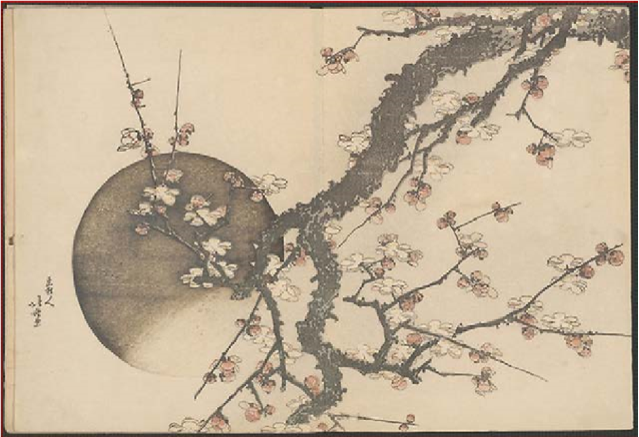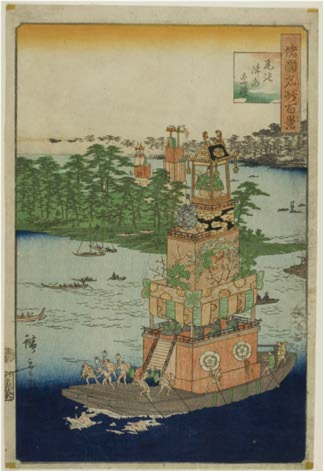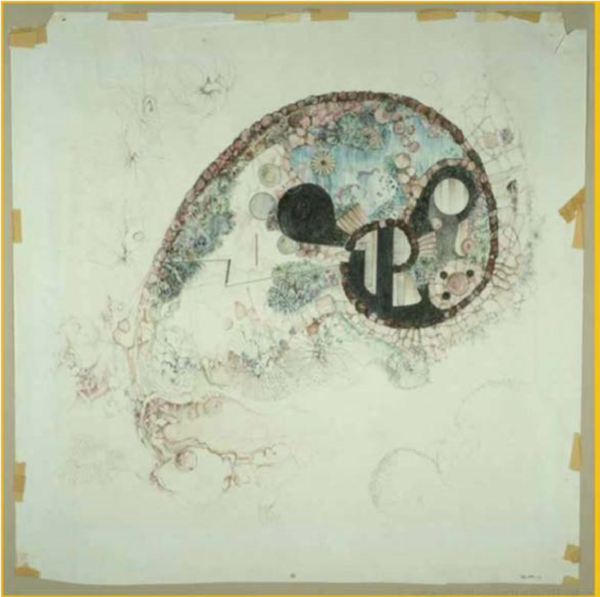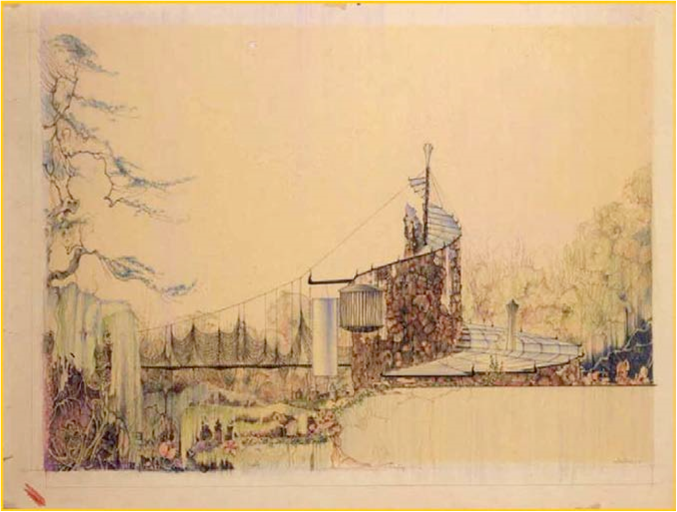Francesca Hankins
Washington-Alexandria Architecture Center, Virginia Tech
fhankins@vt.edu
Credo: I believe the house is more a home by being a work of Art. I believe that man is more a man by being an individual rather than a committee-meeting. For these two reasons, I believe Democracy (though difficult) is the highest known form of society. I believe Democracy is the new innate aristocracy our humanity needs. I believe success in any form consists in making these truths a reality. According to ability. I believe all agencies tending to confuse and frustrate these truths are now continuous and expedient – therefore, to be exposed and rejected. I believe truth to be our organic divinity.
—Frank Lloyd Wright[1]
Introduction
Architect Bruce Goff once remarked that according to Frank Lloyd Wright, architecture came from three places within the architect: from the head, the hand, and from the heart.[2] Both architects, separated by well over a generation were nevertheless practicing at a time in which the definition of Modern architecture,[3] specifically a characteristically American one, was still in debate. Wright defined it as “the offspring of Organic architecture: an offspring, already emasculate and commercialized, in danger of becoming a Style.”[4] And, Goff spoke of the International Style as the source “looking for shelter under the cloak of anonymity…”[5] For Wright and Goff, their Modernism[6]—an Organic architecture was one that retained its “soul.”[7] This paper presents how Goff was influenced by Wright’s philosophy regarding a true and thus organic architecture, but created a unique interpretation of architecture representing the home as a work of art expressing the continuous changes of life.[8]

Figure 1: Bruce Goff with Frank Lloyd Wright, c. 1950s.
The Education of an Artist
Bruce Alonso Goff, born on the same day 37 years later from Frank Lloyd Wright, with whom he considered as “one of the three greatest architects,”[9][10] viewed architecture as one of the many forms of artistic activity in which an inherently close relationship existed to our experience as human beings. In the January 1930 issue of The Western Architect, an essay by a young 26 year old architect, was published entitled, “A Declaration for Independence.” Goff proclaimed that the current state of civilization was at its apogee, which he called the Moderne Movement. However, this great movement cannot exist “unless all of the arts are represented.”[11] He goes on to provide current representative examples from the various arts and sciences and then questions why there are so few in architecture. His argument is, that unlike all the other arts, “architecture has not yet emancipated itself from the forms of the Stone Age, it has been limited to horizontal, vertical, and circular expression.”[12]
For Goff, the heart of the problem was that only a few architects were able to conceive of and represent this movement through a new and free architecture: one that expresses modern forms which evolve through “the expression of the individual.”12 According to Goff, one such architect— a genius, was Frank Lloyd Wright. Goff shared with Wright, not only the same birth date but both not having received a formal architectural education. In fact, Goff spoke frequently of his early education coming from two publications on Wright’s work. His first exposure was at twelve years old when working as an apprentice at the architecture firm of Rush, Endacott & Rush in Tulsa, Oklahoma. The March 1908 issue of Architectural Record was devoted to the work of Frank Lloyd Wright, which Goff recounted, “It knocked me for a loop. I was dumbfounded to see the things in there that I liked so intuitively.”[13] The full issue included eighty-seven drawings and photographs of Wrights work plus his first of sixteen essays, “In the Cause of Architecture.” The second occurrence were the Wasmuth Portfolios which Wright personally gave to Goff as a gift when he was thirteen.[14]
In that March 1908 issue, Wright set out his “propositions” of architecture in the essay “In the Cause of Architecture.”[15] The young Goff, still only a boy of 12 or 13 years old would learn from Wright that Nature furnished the “elemental law and order inherent in all great architecture.”[16] And further, that “a sense of the organic is indispensable to an architect.”[17] For Wright, and therefore for Goff, to gain this inevitable characteristic in terms of architecture as the work of art was from Japanese art. Wright believed true and therefore, democratic architecture to be the “necessary interpretation” of a humane life, writing a “Modern architecture—let us now say organic architecture—is a natural architecture—the architecture of nature, for Nature.”[18] Further, Wright wrote of this “new need” to be expressed through the merging of the garden and the house: “Garden and building may now be one. In any good organic structure it is difficult to say where the garden ends and where the house begins or the house ends and the garden begins—and that is all as should be…”[19] Defined in an earlier essay, “By organic architecture I mean an architecture that develops from within outward in harmony with the conditions of its being as distinguished from one that is applied from without.”[20] Goff would also dedicate his work to the “organic principle [as] the only principle worth working with.”[21] Both architects were guided by core principles summarized in one word, edaburi.

Figure 2: Katsushika Hokusai, Plum Blossom and the Moon from the Book Mount Fuji in Spring (Haru no Fuji), c. 1803. (Source Martin A. Ryerson Collection. The Art Institute of Chicago).
From the Japanese, edaburi 枝ぶりis defined as the formative arrangement or spread of tree branches or shape of its foliage; the appearance of a garden tree with regard to the spread of its branches and leaves, or the balance between the foliage and the trunk.[22] However, the essence of this word is difficult to translation or explain in Japanese let alone English.[23] By breaking it down into two words, it reveals more details. Eda 枝 alone means the elements of the tree, including branches, foliage and buri ぶり translates into style. Returning to Wright’s idea that the “organic is indispensable to an architect,” he continues to provide where this “inevitableness characteristic of a work of art” may be found: “Japanese art knows this school more intimately than that of any people. In common use in their language there are many words like the word ‘edaburi,’ which, translated as near as may be, means the formative arrangement of the branches of a tree.”[24] Goff too, nearly word for word from Wright defined his design process: “The Japanese have words for this, too: edaburi, which means, as nearly as you can say it in English, the formative arrangement of the branches of a tree. In other words, “the sense of order in the design of a particular kind of tree that you would find in the arrangement of its branches … this sense of order isn’t just in the differences of the kinds of leaves; it carries through the textures, all the way through … In nature you find that almost everything has its own kind of order.”[25] And further, “what comes out will have a sense of order and unity with freedom and discipline.”[26] For both Wright and Goff, this sense of order was “organic.”[27]


Fig. 3: Utagawa Hiroshige II (Shigenobu), The Tsushima Festival, 1826-1869.(Source Bruce Goff Archive, gift of Shin’enkan Inc. The Art Institute of Chicago).
Fig. 4: Utagawa Hiroshige II (Shigenobu), Daijin Shrine at Funabashi, Shimosa Province(1860). (Source Bruce Goff Archive, gift of Shin’enkan Inc. The Art Institute of Chicago).
The Home as a Work of Art
During these early decades of the twentieth century, Goff designed buildings, primarily residential based on his expectation that a close relationship existed between all forms of artistic activity and life.[28] In 1978, four years prior to his death, he wrote “Coda: As an Architect” for the occasion of an exhibition of his art and architecture essentially summarizing his life as an architect and what a work of architecture is. An architect who works with the client and builds with the site provides a “work of architecture,” which accommodates “people and their ways of life and will grow organically from within outward thus becoming its own shapes and forms.”[29] The result will continue to grow for their lifetime. For Goff, architecture was the only art which could be physically inhabited, and as such we should “desire to enter or take part in a work of art in order to make it ours.” Similar to literature, Goff remarked how “we involve ourselves with it while we read … in music we must participate in it, as we listen, if we are to understand it. Thus, the “architect’s works are personal and impersonal … timely and timeless.” Goff ends the short essay proclaiming that he will “continue to ‘maintain my amateur standing’ as a beginner, beginning again and again in the continuous present.”[30]
The most famous example of Goff’s residential architecture was the Bavinger House (1945-50) in Norman, Oklahoma. Goff was posthumously awarded the American Institute of Architect’s Twenty-Five Year Award (1987) in recognition of his contribution towards American architecture. It exemplified the early Organic architecture within the Modern Movement. The house “spirals joyously into the Oklahoma sky, cut loose from the earth by a mind as free as the prairie landscape, a celebration of the spirit of man and nature united in architecture,” and “superbly integrates” the inspirational principles of the organic spirit of a playfulness amongst the natural elements water, earth, sky, and fire.[31] It profoundly exhibits Goff’s architectural phenomenological sensitivity to its unique cultural and environmental conditions using local building materials and the inherent landscape of the Midwest. For example, he uses a logarithmic spiral to define the shape of the site, detailed with local rubble stone that weaves the interior with exterior providing sensory properties that give this home its place.

Fig. 2: Bruce Goff, Bavinger house, Norman, OK, 1945; presentation drawing of first floor plan (Source: Art Institute of Chicago).

Fig. 3: Bruce Goff, Bavinger house, Norman, OK, 1945; perspective presentation drawing (Source: Art Institute of Chicago).
[1] Frank Lloyd Wright, the Natural House (New York, N.Y: Horizon Press, 1954).
[2] Bruce Goff, “The Idea of Architecture,” in Goff on Goff: Conversations and Lectures, ed. Philip B Welch (Norman: University of Oklahoma Press, 1996), 170.
[3] See Hilde Heynen, Architecture and Modernity: A Critique, Revised edition (Cambridge, Massachusetts: The MIT Press, 2000).
[4] Frank Lloyd Wright, “Organic Architecture Looks at Modern Architecture, May 1952,” in In the Cause of Architecture: Essays by Frank Lloyd Wright for Architectural Record, 1908-1952, with a Symposium on Architecture With and Without Wright by Eight Who Knew Him, ed. Frederick Gutheim (New York: Architectural Record, A McGraw-Hill Publication, 1987), 233.
[5] Bruce Goff, “Goff on Debussy,” in Goff on Goff: Conversations and Lectures, ed. Philip B Welch (Norman: University of Oklahoma Press, 1996), 280.
[6] Marshall Berman, All That Is Solid Melts into Air: The Experience of Modernity (New York, N.Y., U.S.A.: Viking Penguin, 1988), 5, 13.
[7] Wright, “Organic Architecture Looks at Modern Architecture, May 1952,” 238.
[8] Bruce Goff, “The Continuous Present in Architecture,” in Goff on Goff: Conversations and Lectures, ed. Philip B Welch (Norman: University of Oklahoma Press, 1996), 194–95.
[9] Bruce Goff, “Frank Lloyd Wright – Le Roi Des Etoiles” (Typescript with manuscript notations, March 27,
[10] ), Series V, Box FF 1.18, Ryerson and Burnham Archives Ryerson and Burnham Libraries The Art Institute of Chicago, Chicago, IL 60603, http://www.artic.edu/research/archival-collections. The other two architects cited by Goff, Louis Sullivan and Antoni Gaudi.
[11] Bruce Goff, “A Declaration for Independence,” The Western Architect 39 (January 1930): 17.
[12] Goff, 17. 12 Goff, 17.
[13] Bruce Goff, “Goff’s Creative Growth and Design Philosophy,” in Goff on Goff: Conversations and Lectures, ed. Philip B Welch (Norman: University of Oklahoma Press, 1996), 20.
[14] Goff, “Frank Lloyd Wright – Le Roi Des Etoiles.”
[15] Wright notes that these “propositions” were first formulated in 1894.
[16] Frank Lloyd Wright, “In the Cause of Architecture, March 1908,” in In the Cause of Architecture: Essays by Frank Lloyd Wright for Architectural Record, 1908-1952, with a Symposium on Architecture With and Without Wright by Eight Who Knew Him, ed. Frederick Gutheim (New York: Architectural Record, A McGraw-Hill Publication, 1987), 53.
[17] Wright, “In the Cause of Architecture, March 1908.” 53.
[18] Wright, “First Evening,” An Organic Architecture, 3.
[19] Wright, “Second Evening,” 12.
[20] Wright, “In the Cause of Architecture, March 1908,” 122.
[21] Bruce Goff, “The New and Different in Architecture,” in Goff on Goff: Conversations and Lectures, ed. Philip B Welch (Norman: University of Oklahoma Press, 1996), 92.
[22] “Japanese Garden Dictionary: A Glossary for Japanese Gardens and Their History,” www.nabunken.go.jp, accessed May 5, 2018, https://www.nabunken.go.jp/org/bunka/jgd/index.html.
[23] Author’s conversation with Doug Wilson and his Japanese wife Sanae, March 2019.
[24] Wright, “In the Cause of Architecture, March 1908,” 53–54.
[25] Philip B. Welch, Ed. Goff on Goff: Conversations and Lectures (Norman & London: University of Oklahoma Press, 1996): 40.
[26] Ibid. 42.
[27] Frank Lloyd Wright, In the Cause of Architecture, ed. Frederick Gutheim (New York, 1987): 53.
[28] Goff, “A Declaration for Independence.”
[29] Bruce Goff, Architecture: [Published on the Occasion of an Exhibition of the Art and Architecture of Bruce Goff for Presentation at the Yellowstone Art Center, Billings, Montana, May 5-June 11, 1978 (Billings, Mont.: Yellowstone Art Center, 1978).
[30] Goff.
[31] David Pearson, New Organic Architecture: The Breaking Wave (Berkeley, 2001): 1.



